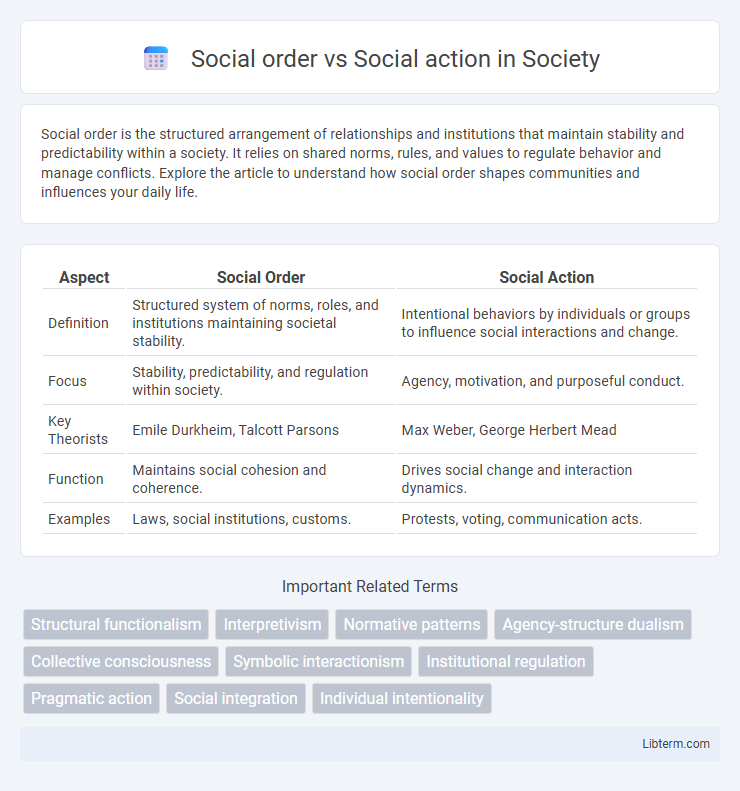Social order is the structured arrangement of relationships and institutions that maintain stability and predictability within a society. It relies on shared norms, rules, and values to regulate behavior and manage conflicts. Explore the article to understand how social order shapes communities and influences your daily life.
Table of Comparison
| Aspect | Social Order | Social Action |
|---|---|---|
| Definition | Structured system of norms, roles, and institutions maintaining societal stability. | Intentional behaviors by individuals or groups to influence social interactions and change. |
| Focus | Stability, predictability, and regulation within society. | Agency, motivation, and purposeful conduct. |
| Key Theorists | Emile Durkheim, Talcott Parsons | Max Weber, George Herbert Mead |
| Function | Maintains social cohesion and coherence. | Drives social change and interaction dynamics. |
| Examples | Laws, social institutions, customs. | Protests, voting, communication acts. |
Understanding Social Order: Definition and Importance
Social order refers to the structured and stable arrangements within a society that regulate individual and group behavior through established norms, laws, and institutions, ensuring predictability and cooperation. Understanding social order is crucial for analyzing how societies maintain cohesion and prevent chaos by balancing control and freedom. This concept is fundamental in sociology and political science, as it explains the mechanisms that underpin social stability and collective well-being.
Exploring Social Action: Meaning and Key Concepts
Social action refers to behaviors individuals perform with conscious intention, aiming to influence or respond to others within a social context. Max Weber's framework categorizes social action into four types: instrumental rationality, value rationality, affective action, and traditional action, each highlighting different motivations guiding human behavior. Understanding social action emphasizes individual agency, intentionality, and meaning-making, contrasting with social order which centers on established patterns and structures maintaining societal stability.
Historical Perspectives on Social Order and Social Action
Historical perspectives on social order emphasize the role of institutions, traditions, and norms in maintaining societal stability and preventing chaos, as seen in the works of Emile Durkheim and Talcott Parsons. In contrast, social action focuses on the individual and collective behaviors that produce and change social structures, highlighted by Max Weber's interpretive sociology and symbolic interactionism. These frameworks collectively illustrate the dynamic interplay between established social systems and the actions of agents that enact, resist, or transform social order over time.
Theoretical Foundations: Durkheim vs. Weber
Emile Durkheim's theory of social order emphasizes the role of collective consciousness and social facts in maintaining societal cohesion and stability, viewing social order as a system of interrelated parts functioning together. Max Weber's perspective on social action centers on individual meanings and intentions, highlighting subjective motivations and the role of interpretive understanding (Verstehen) in shaping social behavior. Their theoretical foundations contrast Durkheim's structural-functionalism with Weber's interpretive sociology, offering distinct yet complementary insights into social dynamics.
How Social Order Shapes Collective Behavior
Social order creates structured norms and shared values that guide collective behavior by establishing predictable patterns and expectations within a society. This framework reduces uncertainty, enabling coordinated actions and cooperation among individuals in groups or communities. As a result, social order stabilizes interactions and fosters cohesive social dynamics essential for the functioning of complex societies.
Individual Agency in Social Action
Social action emphasizes individual agency by highlighting how personal motives, intentions, and choices shape social interactions and influence societal outcomes. Unlike social order, which focuses on established structures and norms maintaining stability, social action centers on the dynamic role of individuals actively interpreting and responding to their social environment. This perspective underscores the capacity of individuals to challenge, modify, or reinforce social arrangements through purposeful behavior.
Conflict and Consensus: Mechanisms of Social Order
Social order is maintained through a balance of conflict and consensus, where consensus fosters cooperation and shared values that stabilize society, while conflict drives social change by challenging existing norms and power structures. Conflict arises from competing interests and inequalities, acting as a catalyst for transformation and renegotiation of social relationships, whereas consensus mechanisms, such as laws, norms, and institutions, create predictability and integration. Understanding these dual processes highlights how social order is dynamically constructed and contested within social action, emphasizing the interplay between stability and change.
Social Institutions: Maintaining and Challenging Order
Social institutions function as structured mechanisms that maintain social order by establishing norms, roles, and regulations essential for societal stability. They also serve as arenas for social action where individuals and groups challenge existing power dynamics, leading to change and transformation. This dual role highlights institutions as both stabilizing forces preserving social cohesion and dynamic spaces fostering social contestation and evolution.
Impact of Social Action on Social Change
Social action, driven by individual and collective behaviors, plays a critical role in initiating social change by challenging existing norms and structures within social order. It mobilizes resources and transforms cultural values, leading to shifts in political, economic, and social institutions. The dynamic interaction between social action and social order ultimately reshapes societal patterns, enabling progressive reforms and adaptation.
Bridging Social Order and Social Action in Modern Society
Social order represents the stable patterns and norms guiding collective behavior, while social action emphasizes individual agency and purposeful acts within these structures. Bridging social order and social action in modern society requires understanding how personal choices both shape and are shaped by institutional frameworks and cultural expectations. Integrating insights from sociology and behavioral sciences reveals the dynamic interplay where individuals navigate and transform social systems, fostering adaptability and cohesion in complex environments.
Social order Infographic

 libterm.com
libterm.com